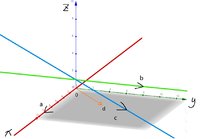This is a vector question seems not difficult but I am having issues.
In R3 space, question is to add two vectors a, b (a,b ∈ R3). a,b,c are vectors that a=[t,0,0], b=[0,t,1], and c= a+b=[t,t,1].
I plotted the chart using software below and you can see vector c is the blue line in the direction between x axis and y axis with a height of 1.
However, in terms of vector addition principles, when adding two vectors a and b, you first moving vector b to the starting point of a (which is the origin in our case) and then add together. using this logic, a+b should equal to vector d (orange line in chart). I know that from parametric form c=[t,t,1] should be the blue line in the chart but what is wrong with the orange line using vector addition principles? thanks!

In R3 space, question is to add two vectors a, b (a,b ∈ R3). a,b,c are vectors that a=[t,0,0], b=[0,t,1], and c= a+b=[t,t,1].
I plotted the chart using software below and you can see vector c is the blue line in the direction between x axis and y axis with a height of 1.
However, in terms of vector addition principles, when adding two vectors a and b, you first moving vector b to the starting point of a (which is the origin in our case) and then add together. using this logic, a+b should equal to vector d (orange line in chart). I know that from parametric form c=[t,t,1] should be the blue line in the chart but what is wrong with the orange line using vector addition principles? thanks!

